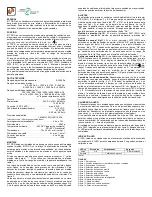
V A L A V I O N I C S L T D
I N S 4 2 9 I N T E G R A T E D N A V I G A T I O N S Y S T E M
I N S T A L L A T I O N A N D O P E R A T O R ’ S M A N U A L
Revision 3
Page 18 of 27
March 2013
9.5
Message Formats
All messages will conform to the NMEA 0183 proprietary message format as follows. All characters will
be standard ASCII characters. No binary data characters will be used.
“$” .....................................Start of message character, ASCII “$” (024h)
“P”.....................................Proprietary message identifier
“MRR” ..............................II Morrow company identifier
c.........................................Message class identifier. Used to identify a message as either a
COMM of VHF NAV message. Those message types, which are also
supported by the VAL COM 2000 VHF Transceiver, will use the “C”
identifier to allow the INS 429 to accept COMM radio commands from
existing products. All other messages will use the “V” identifier to
indicate that they relate to a VHF NAV receiver.
nn ......................................Message identifier, two-digit number in ASCII characters.
d…d ..................................Message data characters defined for each message.
chksum ..............................Message checksum, including message identifier through data
characters. The two-digit checksum is generated by adding all values
of valid characters together, ignoring carry (if any). This value is
converted into two encoded hex
1
characters (30h-3Fh).
<CR>.................................ASCII carriage return (0Dh)
<LF> .................................ASCII line feed (0Ah)
The maximum message length, including the start of message character (“$”) and the end of message
<CR><LF> sequence, is 25 bytes.
This message format is the same as is used in the INS 429 / NAV 2000 / NAV 2KR. The COM 2000 /
COM 2KR will be able to accept all messages intended for a INS 429 / NAV 2000 / NAV 2KR without
generating a serial communications error. It will ignore all of those messages. Those messages have been
included for completeness.
1
Encoded Hex: each character consists of 4 bits of data placed in the low order 30h. For example, the 8-bit
value of 5Fh would be encoded as two characters with values of 35h and 3Fh, which map to the ASCII characters
“5” and “?” respectively.










































